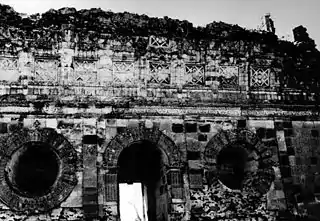Catholic Church in Ethiopia
The Catholic Church in Ethiopia is part of the worldwide Catholic Church, under the spiritual leadership of the Pope in Rome.
| Part of a series on the |
| Catholic Church by country |
|---|
.svg.png.webp) |
|
|

The Oriental Ethiopian Catholic Church, the primary organization of Catholicism in the country, is especially close to the Ethiopian Orthodox Tewahedo Church, whose doctrine and liturgical tradition it shares. While separated by their understanding of the primacy of the Bishop of Rome, the Ethiopian Catholic and Orthodox Churches have basically the same sacraments and liturgy. As of 2010, there were 610,714 members of the Ethiopian Catholic Church.[1] There are also a small number of Latin-Rite Catholics in the country, primarily Italian Ethiopians.
History
Around the year 341 A.D., Saint Frumentius (Abune Salama Kesatie Berhan) was consecrated the first Bishop of Ethiopia by the great Saint Athanasius, Patriarch of Alexandria, who was in union with the Bishop of Rome. Thus the Bishop of Alexandria was the bridge between the Bishop of Rome and the Bishop of Ethiopia.
When the Church in Alexandria and in Ethiopia split from the Church in Rome in the sixth century, the Church which had been one became divided.
Between the 13th - 18th centuries, various consistent missionary attempts had been carried out in Ethiopia to re-introduce Catholicism. Since there was already a Christian church in the Country, most of the missionary attempts were not concerned with the conversion of the non-Christians, but securing the adhesion to the Holy See of the existing Church. Yet these missions eventually failed due to the national-religious attachment of the Ethiopians, in particular, the Coptic party, to their Miaphysite doctrine, and the strict link between religious and political struggles.
The Portuguese voyages of discovery at the end of the fifteenth century opened the way for direct contacts between the Church in Rome and the Church in Ethiopia. Due largely to the behaviour of the Portuguese Jesuit Afonso Mendes, whom Pope Urban VIII appointed as Patriarch of Ethiopia in 1622, Emperor Fasilides expelled the Patriarch and the European missionaries, who included Jerónimo Lobo, from the country in 1636; these contacts, which had seemed destined for success under the previous Emperor led, instead, to the complete closure of Ethiopia to further contact with Rome.
From 1839 Msgr. Justin de Jacobis, and subsequently Cardinal Guglielmo Massaia, resumed Catholic missionary activities. The Catholic communities currently found in Ethiopia are mostly the fruit of the vigorous work of the above-mentioned missionaries, de Jacobis, and Cardinal Massaja.
See also
Notes
- "Dioceses". Ethiopian Catholic Agency. Ethiopian Catholic Church. Archived from the original on 21 March 2013. Retrieved 7 October 2013.
External links
- Ethiopian Catholic Secretariat official website